|
DEPARTMENT OF THE INTERIOR
Conservation in the Department of the Interior |

|
CHAPTER XV
CONSERVATION BY THE GENERAL LAND OFFICE
THE General Land Office in the Department of the Interior has been the real-estate agency of the Government almost from the moment when there first was a government. It began offering land for sale in 1785 and since that time has disposed of about three-fourths of the continental area of the United States. Roughly speaking, it has sold all the land north and west of the Ohio and Mississippi, plus Alabama, Mississippi, and Florida, with the exception of Texas, which retained its public lands when it joined the Union.
When the original thirteen Colonies became States under the Constitution they kept their own lands. Several of these States, however, owned lands running to the Mississippi. About the time they came into the Union under the Constitution they gave up their title to this land, and it became public domain, belonging to the Federal Government. When Florida and Louisiana later were purchased all their lands that had not gone into private ownership were added to the public domain. The Louisiana Purchase included all that fertile area in the Mississippi River drainage basin west of the river. Unappropriated lands in those areas acquired from Mexico, and in Oregon and Washington acquired through exploration, also became part of the public domain. Thus was an empire set aside for later development.
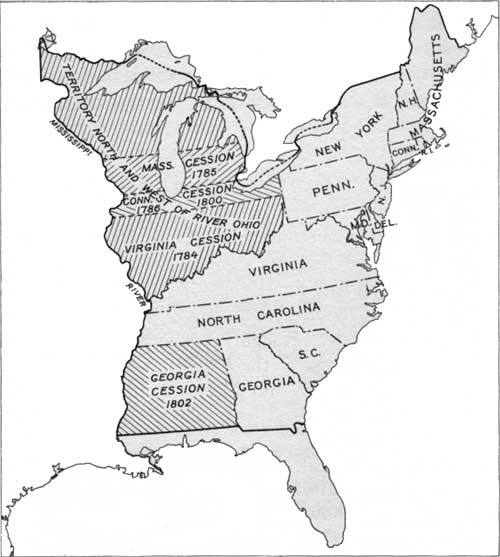
|
| Ceded Lands of the Original States |
In 1784 the Continental Congress appointed a committee headed by Thomas Jefferson to draft "an ordinance for ascertaining the mode of locating and disposing of lands in the western territory." A report of that committee in the handwriting of Jefferson himself recommended a plan, new under the sun, for surveying and selling this, the most valuable stretch of land in all the world. A pattern was made by which the map of the Nation was to be cut up in an orderly way that would make it possible that any bit of it anywhere could be conveniently located and a fence built around it as the tide of settlers rolled westward to the Pacific coast. All lines were in accordance with the cardinal points—ran north and south, east and west. Jefferson, being an enthusiast for the metric system, drew a plan which provided a checkerboard for the entire country with blocks 10 miles square, each divided into 100 sections, 1 mile square. The New England township, which was 6 miles square, had come into general acceptance, however, and it later became the basic measure. With the location of base lines and principal meridians and the designations of townships, ranges, and sections, it became possible conveniently to identify any tract of land anywhere and give it a place on the map. The public-land States were laid out on this rectangular plan, admittedly the most convenient scheme ever devised by any nation.
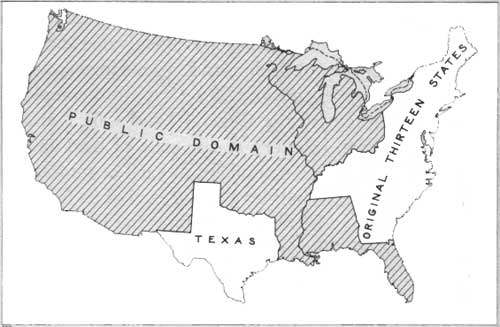
|
| The Public Domain That Has Born the Charge of the General Land Office |
The first township of public lands to be surveyed in the new Nation was in 1785. It was based on Ellicott's line, which was the boundary between Pennsylvania and Ohio.
The survey of the public domain has gone forward steadily from that day to this and is yet far from completed. Roughly, a survey by the General Land Office contemplates the location of every square mile of land and the placing of a permanent monument at each of its four corners and a monument half way down each of its four sides that crosslines may be run establishing the boundaries of quarter sections. The area between the Ohio River and the Pacific, between Mexico and Canada, is so vast that this task of marking out all these sections has proven almost without end. The work has gone steadily forward through the decades for nearly a century and a half, sometimes consuming appropriations of more than a million dollars a year. In the beginning there were some 2,000,000,000 acres of this public land in continental United States. About 140,000,000 acres are still unsurveyed. The Government at present is spending around $700,000 a year in continuing these surveys.
Government lands were at first sold at auction for cash, the purpose being to raise money for payment of the public debt. Settlers were discouraged from locating on these lands, as this might interfere with sales. The first step toward the best use which constitutes conservation came in 1820 when a "preemption" law was passed under which the settler on Government land acquired first right to buy it at $1.25 an acre. In 1862 the homestead law was passed. Under it a bona fide settler, a citizen of the United States, might acquire title to a quarter section of Government land by making his home on it for a period of five years. This law, withholding public lands for legitimate home makers, is held by many to have turned out to be the greatest of all conservation measures. It was under it that those hordes of settlers which swept west at the close of the Civil War found permanent homes with their feet in the soil.
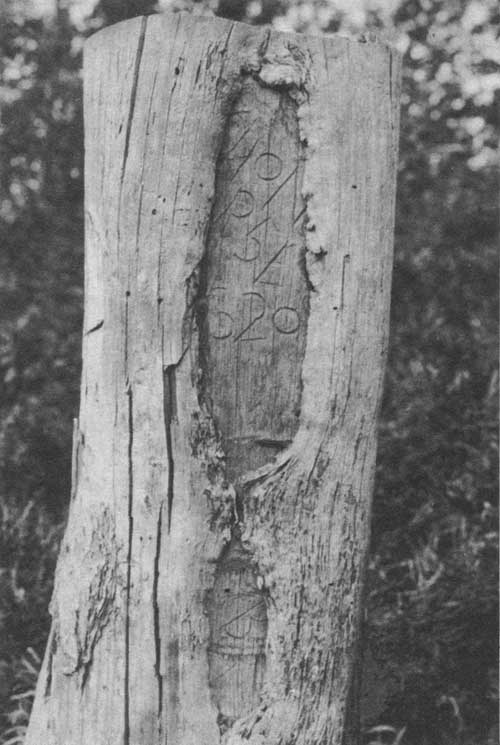
|
| A Section Corner Marked on a Tree in 1864 and Photographed 62 Years Later |
As early as 1873 forestation found a place in the administration of the Land Office in the timber culture act, which made possible the acquisition of Government land as a reward for planting trees on it. Timberlands were withdrawn from settlement in 1891 and a division of the Land Office administered them until the Forest Service was created more than a decade later.
In 1909, 47 years after the passage of the homestead act, it came to pass that most of the good farm land between Pittsburgh and the Pacific had been appropriated, quarter section at a time, by settlers. The activities of the Land Office had kept pace with the frontier while settlers overflowed into State after State. The usual action of the Federal Government has been to distribute land resources into private hands as fairly and rapidly as possible. Certain artificial conceptions, such as that of the acre, have been used in dividing up our continent just as we have divided up our cities into town lots of arbitrary size and shape. This has been done largely regardless of the quality of the soil, the amount of vegetation, the water supply, the climate, or those other factors upon which all of the values of the soil, in so far as the habitation of human beings is concerned, depend. The result of this has been that there has been a large marginal failure in almost every zone throughout the country. In the best areas of the Middle West this process has not been so evident, but throughout the Rocky Mountain region and the Western States the tragic skeletons of abandoned homes tell the gaunt and heartless story of human hardship and of a contest with nature doomed to failure. Purely artificial procedures and arbitrary decisions are not apt to fit well unless all the conditions are favorable. This whole sad process of failure could have been avoided if we had understood the problems of spreading a great population over a continent for successful living.
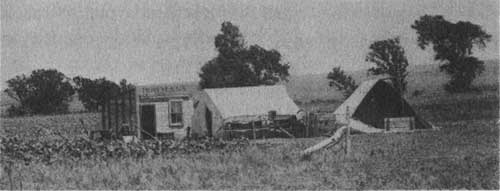
|
| The Scene of a Settler's Fight for a Home |
Yet despite all of this the smoke of contentment curls from a million chimneys where previously desolation reigned. There still remained in 1909 a type of land capable of being cultivated by dry-farming methods that was not taken by settlers because a quarter section of it would not produce enough to support a family. If two quarter sections, side by side, could be acquired, a crop might be made each year on one of them while the other lay fallow and conserved its moisture. An enlarged homestead act was passed permitting the settler to file on 320 acres. Thus did a great area of border-line lands pass into the hands of homesteaders. In 1916 the stock raising act was passed providing that a 640-acre unit of land suited to the purpose might be acquired by settlers whose inclinations ran to cattle or sheep. Thus was another tier of lands opened to settlement.
Yet another land law passed as early as 1877 permitted "desert-land entries." A citizen might file on a tract of desert land. To get a patent to it he must find a way of getting water on it, of actually cultivating it. The land would be given to whoever developed a one-man reclamation project. This act represented the Government's first effort toward the encouragement of irrigation. In 1894 the Carey Act was passed which turned over to States, under prescribed conditions, lands to reclaim where cooperative irrigation projects might be developed. Then finally, in 1902, the Federal reclamation act, under which the Government advanced the money for projects too big to be otherwise handled, came into being. It has brought water to various sagebrush plains from Canada to Mexico and has distributed under careful supervision the fertile lands which, before it waved its wand, were barren wastes.
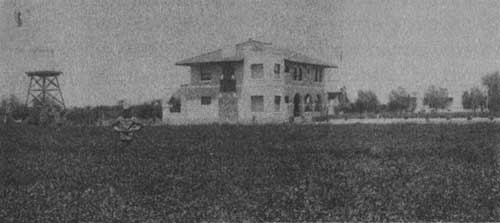
|
| A Reclamation Home |
From the vastness of his public domain Uncle Sam has dispensed largesse with a bountiful hand to those activities which have seemed to him in the public interest. Having early acquired an enthusiasm for public education, he began in 1802 to set aside public lands in the new State which he cut out from his acquired domain in the West certain areas to be conserved for school purposes. When Ohio came into the Union, section 16 of each township was given her for the support of her schools. The 12 States that followed her were on the same basis allowed 1 square mile out of each 36 as a school section. As time passed the Federal Government grew more liberal in its contributions to public education and gave to a score of States following these two sections in each township. As the States finally filed into the Union and it became Utah's turn to make her entrance, she was given for school purposes four sections out of each township. Like amounts have been given to Arizona and New Mexico as they came into the Union. The sum total of this area which was given to the States for educational purposes is so vast as to be hard to comprehend. It makes up a land surface that is equal to all of New England, all of the Middle Atlantic States plus North Carolina and Tennessee.
Beginning in 1849 the Federal Government transferred title of all public swamp lands to the States. The area of all such lands amounted to 65,000,000 acres, or the equivalent of two New Yorks. In Florida 20,000,000 acres out of 38,000,000 were shown to be swamp land and turned over to the State. An area equal to Texas has gone into Indian reservations. Two and a half Connecticuts have been set aside as national parks. Finally there were the grants of lands to transcontinental railroads that they might be induced to build lines to the Pacific coast, thereby developing the country, which amounted to an additional 135,000,000 acres of land, the equivalent of four States like Iowa.
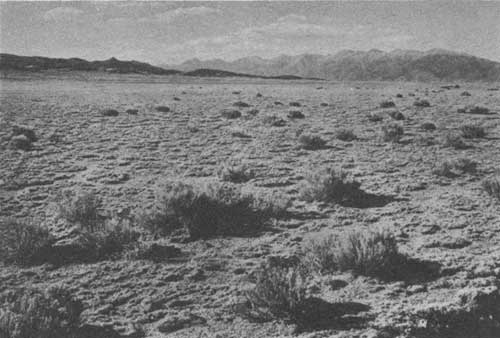
|
| Some of the Public Domain That Nobody Wants |
Thus has the public domain melted away. In the beginning, in round numbers, there were 2,000,000,000 acres of it. To-day one-tenth of it, around 200,000,000 acres, remains, as much of the earth's surface as lies in Iowa, Missouri, Illinois, Wisconsin, and Indiana combined, and with it the problem of its proper administration, from the standpoint of conservation, that the greatest good to the general public may accrue. Of this land a considerable portion still must go to those railroads to which it was granted but to which title has never been transferred because the land has never been surveyed. There are 220,000 sections of land yet to be surveyed and marked with monuments at their corners and halfway down their sides. This completion of western surveys, on which nearly $1,000,000 a year is being expended, is one of the continuing large tasks of the General Land Office.
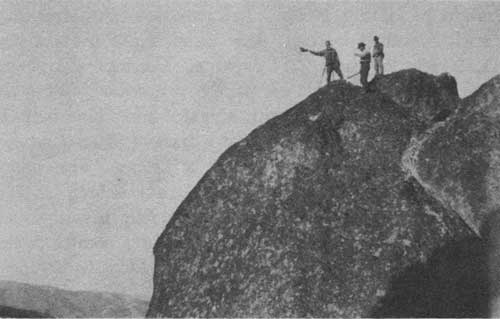
|
| A Point of Vantage for Government Surveyors |
While the sand largely has run through the hourglass for the agricultural lands of the public domain there still is much mineral wealth in them, and responsibility rests on the Government's real-estate office for such disposal of this wealth as to get proper money returns from it and so to prevent its waste as a national resource. From the beginning the Government retained mineral lands, probably on the old English theory that precious metals belong to the crown. When gold was first discovered in California there was next to nothing in existence in the way of mining law. New mining communities became entirely self-governing, struck out boldly, and made their own regulations; some of them were far from orthodox. One, for example, provided whipping and banishment for practicing lawyers, and death for horse and mule stealing.
From these beginnings mining laws later evolved. It came to pass that under the law claims on these lands might be located, worked, and patented. A placer claim might cover 20 acres, a lode claim might cover a strip 1,500 feet long and 600 feet wide. The individual might stake out a claim, file his papers in a county office, and take out great wealth with no more ado. Five hundred dollars' worth of development work and $5 an acre were necessary if he wanted to get a patent. This simple scheme was the backbone of the early mining industry which had to do largely with the precious metals. It was quite adequate even after copper mining became important. Eventually a new law was passed allowing larger but still inadequate areas to be taken as coal land. With the appearance of oil as a new liquid gold, lands bearing it were acquired as placer claims. The production of coal required large land areas and expensive organizations. Oil discovery often was a large undertaking requiring a heavy investment. It cost $250,000, for example, to put down the discovery well at Kettleman Hills. A discovery might inadequately reward the man who made it but enrich holders of land roundabout without effort on their part. In the realm of coal the dummy entrymen, backed by an organized special interest wanting to acquire large areas, became a scandal early in this century. Existing laws were inadequate. Pending the enactment of new laws, large areas of lands believed to be valuable for coal, oil, and fertilizer minerals were withdrawn from entry. A controversy arose out of which grew, in 1920, the enactment of a Federal leasing act for coal and oil lands to supersede the old mining claim procedure. It is in the administration of this law that the Land Office becomes one of the practical conservators of the Government.
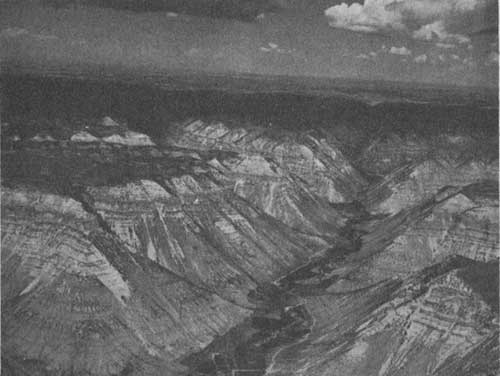
|
| Oil Shale Areas in Colorado |
Under the Federal leasing act the title to coal and oil lands remains permanently in the Government, but the minerals that lie in them may be produced on a royalty basis. The procedure in the case of coal is something like this: The Government blocks out an area which, considering the local circumstances, is regarded as a fit unit for development. Such a unit is likely to be 4 square miles in extent and therefore to cover 2,560 acres. This unit is studied by the Geological Survey, its possibilities are estimated, and a lease is written covering it. This lease may require the development of a plant to cost $10,000 or $50,000. It will call for the production of certain minimum amounts of coal per year, which might be 1,000 tons or 10,000 tons. It will specify the royalty per ton to be paid to the Government, which royalty may vary in proportion to the difficulties in mining the coal. Whether the coal is mined or not, the lease holders must pay royalties on the minimum quantities specified. Thus it becomes unprofitable that coal lands should be held under lease and not worked. When they cease to be worked the lease terminates and they come back to the Land Office.
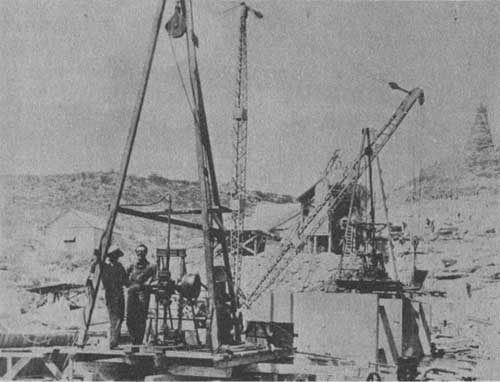
|
| Drilling for Oil Under Government Permit |
The basis upon which the oil lands are handled under the Federal leasing act is a little different. A permit to prospect may be secured for coal lands, but usually prospecting is not necessary, as the presence of the coal is obvious or has been established by the Geological Survey. In the case of oil, however, the permit to prospect is almost always the beginning of an individual's contact with the Government and an important preliminary to a lease. An applicant for a permit to prospect is likely to have 4 square miles of supposed oil land assigned to him. In three months he must stake out its corners. In six months he must have his rig ready to sink an oil well. In a year he must be down 500 feet. In two years, unless he strikes oil at a less depth, he must be down 2,000 feet. His permit should work itself out in two years, but extenuating circumstances may arise under which he may get extensions of the permit up to seven years.
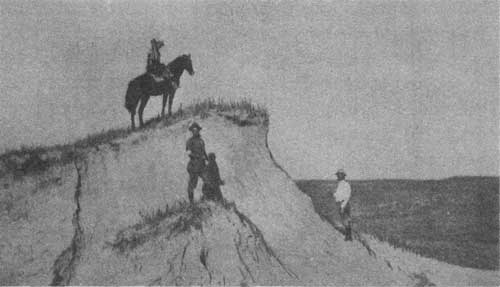
|
| A Government Party Reconnoitering the Public Domain |
If under this permit to prospect the applicant discovers oil, 20 per cent of all that is produced prior to his obtaining a lease goes to the Government. His discovery entitles him to a lease under which he may get one-fourth of the area covered by his permit on a basis of 5 per cent to the Government. He may also secure another lease for three-fourths, but he must pay a royalty to the Government which ranges from 12-1/2 per cent to 33-1/3 per cent, depending on the quantity and quality of the oil produced.
Land leased for either coal or oil remains the property of the Government and returns to the Government when the lessee ceases to produce from it. Thus it remains an asset to the Government for indefinite periods.
As it works out, there lies in this leasing act certain possibilities in the field of conservation that do not appear on the surface. The overproduction of oil had become a menace to the industry before President Hoover came into office. He had been at the helm but seven days when he stopped the issuance of permits to prospect on the ground that there was no occasion for the development of more oil production where there was already too much. This resulted in a certain amount of conservation, but it served a still larger purpose in the example that the Government under the circumstances set to all producers of oil. Later the influence of leased lands was brought to bear in bringing about unit operation at Kettleman Hills. A bill was passed in 1931 specifically authorizing the Secretary of the Interior to enter into such agreements for unit operation.
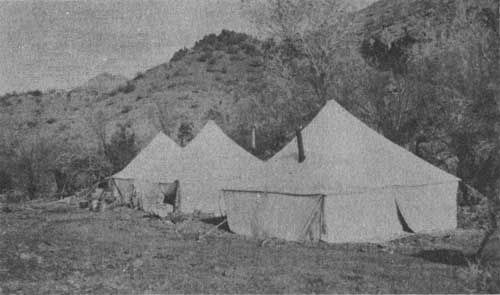
|
| A Land Office Field Camp |
The administration of the General Land Office is one of those few activities of the Government which results in a continuing profit to it. During the decade between 1920 and 1930 the receipts of the General Land Office from all sources amounted to $105,000,000. The expenditures in the operation of the Land Office for the same period amounted to $27,000,000. Thus it appears that there was a profit of some $78,000,000 during this 10-year period of operation. Every time the Land Office spent a dollar it collected four. About 75 per cent of the total receipts are rents and royalties from leases of coal and oil lands, while the remaining moneys result largely from sales of public land. Of the coal and oil money, 10 per cent is retained by the Federal Government, while 90 per cent is divided between the reclamation fund and the States in which the coal and oil is produced. Under this division the reclamation fund gets 37-1/2 per cent of the total and the States get 52-1/2 per cent. Of the money received from the sale of public lands, 5 per cent goes to the States in which the lands lie and the balance, but for small exceptions, to the reclamation fund. Thus does it work out that practically all of the money that is secured from these natural resources is returned to the Western States and spent in them.

| <<< Previous | <<< Contents>>> |
interior-conservation/chap15.htm
Last Updated: 20-Jul-2009